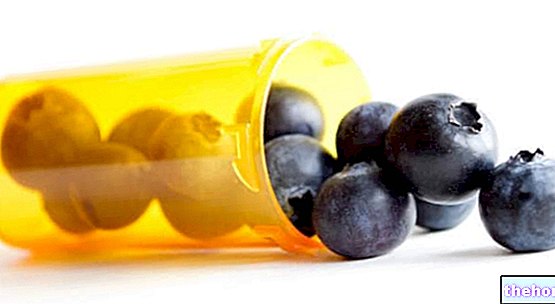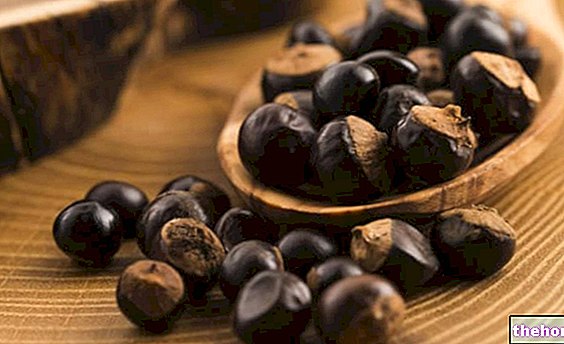Generality
Fucoxanthin is a natural molecule that has made headlines for its alleged ability to reduce excess fat, especially in the abdominal area.
It is a vegetable pigment, a carotenoid typical of brown algae to which it gives its characteristic color, overlapping the green shades of chlorophyll (see figure).

Lower amounts of fucoxanthin are also found in some red and green algae.
The concentration of fucoxanthin in algae, including browns, is however much lower than the doses used to investigate their functional characteristics in animals.
To reach such quantities, it would in fact be necessary to take these foods in doses that make them toxic, due to the large amount of iodine ingested and the consequent risk of hyperthyroidism; Furthermore, we must not forget the numerous reports according to which algae and derived products are in real danger of contamination by arsenic.
Beyond this and their fucoxanthin content, algae are still an excellent source of iodine (which at the appropriate doses is essential to stimulate thyroid activity and basal metabolism) and alginic acid (a polysaccharide that increases the density of gastric contents, stimulating the sense of satiety and acting as a mild mass laxative).
Indications
Why is fucoxanthin used? What is it for?
Although the mechanism of action of fucoxanthin is not yet fully known, recent experimental evidence suggests a particularly complex biological role.
More precisely, fucoxanthin would exert:
- A direct antioxidant activity, acting as a scavenger of oxygen free radicals;
- An "anti-inflammatory activity, effective in reducing the concentrations of inflammatory cytokines such as TNF-alpha and PGE2, normally involved in the genesis of the inflammatory process;
- An antiobesigenic activity, probably linked to the ability of fucoxanthin to control the activity of PPAR gamma upstream and thermogenins downstream.
These two proteins, also known as UCP or uncoupling proteins, are normally expressed in brown adipose tissue, a type of fat that is poorly represented in humans.
With their activity, these proteins seem to contribute to the dissipation of energy obtained from fats, in the form of heat; they would therefore be the basis of an innate defense mechanism of the human body from excess fat and cold. - An "antitumor activity, observed in some preliminary studies on cell cultures, and largely linked to the ability to regulate the rate of proliferation - differentiation of these clones.
Currently the main use of fucoxanthin is mainly oriented to the management of obesity.
Properties and Effectiveness
What benefit has fucoxanthin shown during the studies?
The very interesting properties of fucoxanthin were not enough to push researchers towards the clinical use of this molecule.
Therefore, most of the data currently available derives mainly from experimental evidence, conducted on cell lines or on small laboratory animals.
Unfortunately, to date (February 2016), we only record one clinical study, "Diabetes Obes Metab. 2010 Jan; 12: 72-81." double-blinded versus placebo.
In this trial, fucoxanthin was administered to a group of 151 obese, non-diabetic women, in combination with pomegranate oil, resulting in a weight loss of 4.9 kg over a 16-week period, with significant improvements also in blood indices of liver health.
During the study, a product called Xantigen-600 was used, containing 300mg of pomegranate seed oil combined with 300mg of seaweed extract (which provides 2.4mg of fucoxanthin).
Fucoxanthin has also been shown to increase basal metabolic rate in a dose-dependent manner by up to 8 mg.
It is important to note that these differences only materialized after 16 weeks of treatment (they were not acute), and that the minimum effective dose was 2.4 mg per day.
Pending further investigations, fucoxanthin will continue to be used as a flirtatious ingredient in many food supplements, that is to say as a substance included in the product not so much for its real and proven efficacy, but for the commercial appeal it exercises towards the general public.
In the course of their experiments [1], some Japanese researchers concluded that fucoxanthin promotes the reduction of abdominal fat in genetically obese rats. In the study, the effects of fucoxanthin were investigated at dosages equal to 0.1% and 0.2% of the diet (which proved to be equally effective in the rat, provided that in the first case it is associated with an intake of fish equal to 6.9%); this means that a human being who introduces about 1,000 grams of food per day should, in proportion, take 1,000 / 2,000 mg of fucoxanthin / day.
In other studies, always on rats, fucoxanthin has been tested at doses 10 times lower (0.02%), but still high if transferred to humans (who should take it in doses of about 200mg / day).
If we read the average fucoxanthin content of specific food supplements, we notice how this is around 5/10 mg per tablet; if on the one hand such prudence protects the consumer from the risks of a hypothetical overdose, on the other it is understood how its slimming effectiveness is at least questionable.
Maeda H, Hosokawa M, Sashima T, Miyashita K; Dietary combination of fucoxanthin and fish oil attenuates the weight gain of white adipose tissue and decreases blood glucose in obese / diabetic KK-Ay mice; J. Agric. Food. Chem .; 2007 Sep; 55: 7701-6.
Dosage and method of use
How to use fucoxanthin
At present, there are no studies able to define with certainty an effective and reproducible daily dosage of fucoxanthin.
From various jobs, the most frequent range of use is between 2 and 5 mg per day.
Bioavailability in humans - expressed in terms of increased plasma levels of fucoxanthin after oral intake - would be very modest. Consequently, to overcome this obstacle, the association of fucoxanthin with a dietary source of fat is generally used (in usually a vegetable oil).
At such dosages, the amount of iodine ingested would be very close to that recommended; therefore, it would be advisable to avoid the simultaneous intake of foods containing iodine.
Side effects
Although the correct use of fucoxanthin was generally well tolerated, it would be advisable to remember the potential side effects, both of a metabolic and toxic nature, related to the possible ingestion of foods containing fucoxanthin in large quantities.
These effects are attributable to the massive presence of iodine, which - if taken in excess - disturbs the thyroid and can cause some forms of hyperthyroidism.
Even in supplements, the substance is not always pure; more often extracts ofUndaria pinnatifida titrated at 10% in fucoxanthin, in which there is also a not negligible percentage of iodine.
Therefore, the choice of the appropriate supplement, in terms of product quality and purification, constitutes a key element of the success and tolerability of the supplementary protocol.
When should fucoxanthin not be used?
The use of fucoxanthin is contraindicated in case of hypersensitivity to the substance and contextual thyroid pathologies.
Pharmacological interactions
What drugs or foods can modify the effect of fucoxanthin?
The metabolic action of fucoxanthin exposes this molecule to noteworthy drug interactions.
More precisely:
- The contextual use of cholestyramine, colestipol, mineral oils, orlistat and pectin could reduce intestinal absorption of fucoxanthin;
- The intake of beta carotene, vegetable and animal oils and medium-chain triglycerides, on the other hand, could increase the intestinal absorption of fucoxanthin.
Precautions for use
What do you need to know before taking fucoxanthin?
The use of fucoxanthin during pregnancy and subsequent breastfeeding, as well as in children, should be avoided.
On the other hand, close medical supervision during the use of fucoxanthin would be necessary in patients suffering from various types of pathologies or undergoing concomitant drug therapy.
The use of foods containing fucoxanthin could bring large quantities of iodine, with possible metabolic consequences.
Select plant Fir Acacia Acerola Sorrel Yarrow Yarrow Yarrow Aconito Adatoda Garlic Agnocasto Agrimonia Alchemilla Alkekengi Aloe Altea Witch Hazel Ammi or Visnaga Pineapple Andrographis Anemone Pulsatilla Angelica Anise Star Anise Japanese Star Anise Bitter Orange Bitter Areca Arnica Harpagophytum Arpagophyte Artemisia Asteragus Basil Asparagus Asparagus Peruvian Asparagus Asparagus Asparagus Hawthorn Boldo Borage Shepherd's Purse Boswellia Bucco Butea superba Cocoa Coffee Cajeput Calamus Calamus Marigold Camedrio Chamomile Roman Chamomile Camphor Cinnamon Ceylon Maidenhair Capuchin Artichoke Cardamom Cardiac Thistle Asian Thistle Carvi Cascara Cassia Catecu Catha Cabbage Celandine Chicory Centaurea Cinnamon Cypress Celandine Chives Cypress Coca Cola Colchico Combreto Condurango Comfrey Coriander Cranberry Barberry American Chrysanthemum Cumin Turmeric Damiana Digital Dioscorea Drosera Dulcamara Dunalilella Echinacea Eder a Ephedra Elenio Eleutherococcus Helichrysum Evening primrose Horsetail Alfalfa Erica Euphrasia Erisimo Escolzia Eucalyptus Farfara Farfaraccio Calabar bean Fenugreek Fennel Phytolacca Frangola Ash Fumaria Japanese Mushrooms Galega Ganoderma lucidum Garcinia Cambogia Mulberry Gentian Broom Ginkgo Ginkgo Guipana Guipana Gynestra Ginkgo Hibelia Gymnasium Hibiscus Guarulp St. John's Wort Horse Chestnut Ispaghul Hyssop Jaborandi Kava kava Konjac Laminaria Cherry Laurel Lavender Lemongrass Lespedeza Lovage Icelandic Lichen Lemon Flax Lippia Licorice Lobelia Hops Maca Marjoram Maize Mallow Manna Marrubio Marrubio d "water Matè Melaleuca Meliloto American Lemon balm Myrtle Myrama Walnut Nutmeg Walnut vomica Olive tree Meadowsweet Ononide Opuntia Oregano Orthosiphon Nettle Poppy Papaya Parietaria Feverfew Passiflora Chilli Perilla Periwinkle Phyllanthus Plantain Picrorhiza Pilosella Pino Pisci dia Podofillo Polygala Grapefruit Parsley Psyllium Pueraria mirifica Butcher's broom Pygeum Quassia Oak Rhubarb Ratania Rauwolfia currant Castor bean Rhodiola Rosehip Rosemary Rue Willow Sarsaparilla Sage Elderberry Sassafras Sedum Ergot Senna Serenoa Repens Soybean Solidago Tansy Taraxus Tamarind Tamarind Tamarind Tamarind Tamarindo Ursina Valerian Vanilla Mullein Verbena Veronica Viburnum Vinca Pansy Mistletoe Vine Withania Yohimbe Saffron Ginger Pumpkin Select disease Juvenile Acne Rosacea Tinnitus Tinnitus Aerophagia Tendon Affections Afonia Aphthae Algias Functional Halitosis Breastfeeding Allergy Anemia Anguish Anxiety Arteriosclerosis Asthrosis Asthrosis Arthritis Arthritis Men Sex Woman Blepharitis and Conjunctivitis Eye bags Bronchitis Gallstones Kidney stones Salivary stones Baldness Androgenetic Candida Fragile hair Caries Headache Cellulitis Motion sickness Cystitis C limaterio Cholecystopathy High cholesterol Ulcerative colitis Colonoscopy Contusions Hematoma Convalescence Couperose Depression Dermatitis Diaper dermatitis Diabetes Diarrhea Erectile dysfunction Dyslipidemia Dysmenorrhea Dyspepsia Disturbances of vision Hemorrhoids Epistaxis Herethism Heart disease Fever Fibromyalgia Gastro-intestinal disease Flatulence Hypertension Fibromyalgia Gastrointomnia Jaundice Laryngitis Renal lithiasis Toothache Sore throat Thinness Menopause Meteorism Mononucleosis Alzheimer's disease Crohn's disease Nausea Vomiting Obesity Dark circles Onychomycosis Osteoporosis Dry skin Periarthritis Piorea Low pressure Prostatitis Psoriasis Colds Breast fissures Anal fissures Gastro-nasal rhinitis Senescence Premenstrual Syndrome Sinusitis Quit smoking Overweight Fatty liver Constipation Stomatitis Stress Cough Triglycerides high Ulcer Burns Nails Brittle flashes Heat Warts Dizziness Properties herbal Tanning Abortive adaptogenic Aphrodisiac bittering analgesic anesthetic anorectics analgesic antacid anti-allergic anti-asthmatic Antibiotic catarrh Anticellulitiche anticonvulsant Antidiaforetiche antidiarrheal edematous anthelmintic antiemetic Antiemorroidarie antiphlogistic Antiidrotiche Antinevrotiche Antioxidants antipyretic antirheumatic antiscorbutic Antiseptic antispasmodic anti-uric Aperitive Flavoring Astringent Balsamic Bechiche Capillarotrope Cardiotonic Carminative Cathartic Caustics Healing Cholagogues Choleretic Dyes Decongestants Deodorants Purifying Diaphoretic Cleansers Disinfectants Detoxifiers Thirst quenching Diuretics Exciting Emetics Emmenagogues Emollients Hemostatic Energies Hepatoprotectors Expectorants Eupepticus Moisturisers Galactosensitizers lanti Hypertensive Hypnotic Hypoglycemic Hypotensive Irritants Laxatives Soothing Narcotic Nerves Nutrients Odontalgic Pectoral Purgative Revulsive Remineralizing Refreshing Rubefacient Scialagoghe Sedative Soporifugas Sneezing Stomachic Stomatics Narcotic Vascular Tightenitis
















.jpg)











